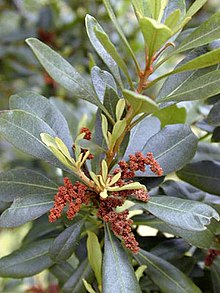Myricaceae
Appearance
This article needs additional citations for verification. (June 2016) |
| Myricaceae | |
|---|---|

| |
| Myrica faya | |
| Scientific classification | |
| Kingdom: | Plantae |
| Clade: | Tracheophytes |
| Clade: | Angiosperms |
| Clade: | Eudicots |
| Clade: | Rosids |
| Order: | Fagales |
| Family: | Myricaceae A.Rich. ex Kunth[1] |
| Type genus | |
| Myrica L. 1753
| |
| Genera | |
|
Canacomyrica Guillaumin | |

| |
| The range of Myricaceae. | |
Myricaceae is a small family of dicotyledonous shrubs and small trees in the order Fagales with its type genus Myrica, the sweet gales. There are three genera in the family, although some botanists separate many species from Myrica into a fourth genus Morella. About 55 species are usually accepted in Myrica (with Morella included), one in Canacomyrica, and one in Comptonia.[2]
Well-known members of this family include bayberry and sweetfern.
- Canacomyrica Guillaumin 1940
- Comptonia L'Hér. ex Aiton 1789
- Myrica L. 1753 (includes: Morella Lour. 1790)
Systematics
[edit]Modern molecular phylogenetics suggest the following relationships:[3]
| |||||||
References
[edit]Wikimedia Commons has media related to Myricaceae.
- ^ Angiosperm Phylogeny Group (2009). "An update of the Angiosperm Phylogeny Group classification for the orders and families of flowering plants: APG III" (PDF). Botanical Journal of the Linnean Society. 161 (2): 105–121. doi:10.1111/j.1095-8339.2009.00996.x. hdl:10654/18083. Retrieved 2013-07-06.
- ^ Christenhusz, M. J. M.; Byng, J. W. (2016). "The number of known plants species in the world and its annual increase". Phytotaxa. 261 (3): 201–217. doi:10.11646/phytotaxa.261.3.1.
- ^ Xiang XG, Wang W, Li RQ, Lin L, Liu Y, Zhou ZK, Li ZY, Chen ZD (2014). "Large-scale phylogenetic analyses reveal fagalean diversification promoted by the interplay of diaspores and environments in the Paleogene". Perspectives in Plant Ecology, Evolution and Systematics. 16 (3): 101–110. doi:10.1016/j.ppees.2014.03.001.
